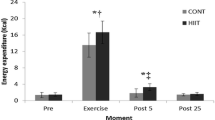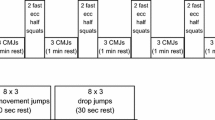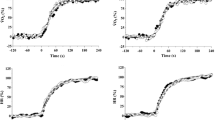Abstract
We investigated the effects of short duration running training on resting and exercise lung function in healthy prepubescent children. One trained group (TrG) (n = 9; three girls and six boys; age = 9.7 ± 0.9 year) participated in 8 weeks of high-intensity intermittent running training and was compared to a control group (ContG) (n = 9; four girls and five boys; age = 10.3 ± 0.7 year). Before and after the 8-week period, the children performed pulmonary function tests and an incremental exercise test on a cycle ergometer. After the 8-week period, no change was found in pulmonary function in ContG. Conversely, an increase in forced vital capacity (FVC) (+7 ± 4% ; P = 0.026), forced expiratory volume in one second (+11 ± 6% ; P = 0.025), peak expiratory flows (+17 ± 4% ; P = 0.005), maximal expiratory flows at 50% (+16 ± 10% ; P = 0.019) and 75% (+15 ± 8% ; P = 0.006) of FVC were reported in TrG. At peak exercise, TrG displayed higher values of peak oxygen consumption (+15 ± 4% ; P<0.001), minute ventilation (+16 ± 5% ; P = 0.033) and tidal volume (+15 ± 5% ; P = 0.019) after training. At sub-maximal exercise, ventilatory response to exercise \( (\Delta \dot V_{\text{E}} /\Delta \dot V_{{\text{CO}}_2 } ) \) was lower (P = 0.017) in TrG after training, associated with reduced end-tidal partial oxygen pressure (P<0.05) and higher end-tidal partial carbon dioxide pressure (P = 0.026). Lower deadspace volume relative to tidal volume was found at each stage of exercise in TrG after training (P<0.05). Eight weeks of high-intensity intermittent running training enhanced resting pulmonary function and led to deeper exercise ventilation reflecting a better effectiveness in prepubescent children.






Similar content being viewed by others
References
American Thoracic Society (1987) Standardization of spirometry—1987 update. Official statement of American Thoracic Society. Respir Care 32:1039–1960
Backer V, Ulrik CS (1992) Bronchial responsiveness to exercise in a random sample of 494 children and adolescents from Copenhagen. Clin Exp Allergy 22:741–747
Baquet G, Berthoin S, Dupont G, Blondel N, Fabre C, van Praagh E (2002) Effects of high intensity intermittent training on peak VO(2) in prepubertal children. Int J Sports Med 23:439–444
Baquet G, van Praagh E, Berthoin S (2003) Endurance training and aerobic fitness in young people. Sports Med 33:1127–1143
Baxter-Jones ADG, Helms PJ (1996) Effects of training at a young age: a review of young athletes (TOYA) study. Pediatr Exerc Sci 8:310–327
Borg GA (1982) Psychophysical bases of perceived exertion. Med Sci Sports Exerc 14:377–381
Clanton TL, Dixon GF, Drake J, Gadek JE (1987) Effects of swim training on lung volumes and inspiratory muscle conditioning. J Appl Physiol 62:39–46
Cooper DM, Kaplan MR, Baumgarten L, Weiler-Ravell D, Whipp BJ, Wasserman K (1987) Coupling of ventilation and CO2 production during exercise in children. Pediatr Res 21:568–572
Courteix D, Obert P, Lecoq AM, Guenon P, Koch G (1997) Effect of intensive swimming training on lung volumes, airway resistance and on the maximal expiratory flow-volume relationship in prepubertal girls. Eur J Appl Physiol Occup Physiol 76:264–269
Daniels J, Oldridge N (1971) Changes in oxygen consumption of young boys during growth and running training. Med Sci Sports 3:161–165
Durnin JV, Rahaman MM (1967) The assessment of the amount of fat in the human body from measurements of skinfold thickness. Br J Nutr 21:681–689
Ekblom B (1969) Effect of physical training in adolescent boys. J Appl Physiol 27:350–355
Engstrom I, Eriksson BO, Karlberg P, Saltin B, Thoren C (1971) Preliminary report on the development of lung volumes in young girl swimmers. Acta Paediatr Scand Suppl 217:73–76
Farrell PA (1981) Maximal expiratory flow-volume relationships before and after eight weeks of endurance training. J Sports Med Phys Fitness 21:145–149
Gratas-Delamarche A, Mercier J, Ramonatxo M, Dassonville J, Prefaut C (1993) Ventilatory response of prepubertal boys and adults to carbon dioxide at rest and during exercise. Eur J Appl Physiol Occup Physiol 66:25–30
Koch G, Eriksson BO (1973) Effect of physical training on anatomical R-L shunt at rest and pulmonary diffusing capacity during near-maximal exercise in boys 11–13 years old. Scand J Clin Lab Invest 31:95–103
Lanteri CJ, Sly PD (1993) Changes in respiratory mechanics with age. J Appl Physiol 74:369–378
Mandigout S, Lecoq AM, Courteix D, Guenon P, Obert P (2001) Effect of gender in response to an aerobic training programme in prepubertal children. Acta Paediatr 90:9–15
Mannix ET, Roberts M, Fagin DP, Reid B, Farber MO (2003) The prevalence of airways hyperresponsiveness in members of an exercise training facility. J Asthma 40:349–355
Martin BJ, Weil JV, Sparks KE, McCullough RE, Grover RF (1978) Exercise ventilation correlates positively with ventilatory chemoresponsiveness. J Appl Physiol 45:557–564
Nagano Y, Baba R, Kuraishi K, Yasuda T, Ikoma M, Nishibata K, Yokota M, Nagashima M (1998) Ventilatory control during exercise in normal children. Pediatr Res 43:704–707
Pianosi P, Wolstein R (1996) Carbon dioxide chemosensitivity and exercise ventilation in healthy children and in children with cystic fibrosis. Pediatr Res 40:508–513
Prefaut C, Peslin R (1986) [Breath tests or measurement of lung volume and bronchial flow]. Rev Mal Respir 3:323–332
Rowland TW (1996) Developmental exercise physiology human kinetics. Champaign pp 27–47
Rowland TW, Boyajian A (1995) Aerobic response to endurance exercise training in children. Pediatrics 96:654–658
Rundell KW, Jenkinson DM (2002) Exercise-induced bronchospasm in the elite athlete. Sports Med 32:583–600
Smith CM, Anderson SD, Walsh S, McElrea MS (1989) An investigation of the effects of heat and water exchange in the recovery period after exercise in children with asthma. Am Rev Respir Dis 140:598–605
Sundberg S, Elovainio R (1982) Cardiorespiratory function in competitive endurance runners aged 12–16 years compared with ordinary boys. Acta Paediatr Scand 71:987–992
Tanner J (1962) Growth at adolescence B. Scientific, Oxford pp 325
Vaccaro P, Clarke DH (1978) Cardiorespiratory alterations in 9 to 11 years old children following a season of competitive swimming. Med Sci Sports 10:204–207
Vaccaro P, Poffenbarger A (1982) Resting and exercise respiratory function in young female child runners. J Sports Med Phys Fitness 22:102–107
Whipp B, Pardy R (1986) Breathing during exercise American Physiology Society, Bethesda
Zauner CW, Maksud MG, Melichna J (1989) Physiological considerations in training young athletes. Sports Med 8:15–31
Zinman R, Gaultier C (1987) Maximal static pressures and lung volumes in young female swimmers:one year follow-up. Pediatr Pulmonol 3:145–148
Acknowledgements
We thank the Beuvry hospital which welcomed us for the experiments, Mr JM Grosbois for his technical assistasnce, the teachers and all the children from the Jean Monnet primary Illies School who participated enthusiastically in this study and the school authorities of Lille (France).
Author information
Authors and Affiliations
Corresponding author
Rights and permissions
About this article
Cite this article
Nourry, C., Deruelle, F., Guinhouya, C. et al. High-intensity intermittent running training improves pulmonary function and alters exercise breathing pattern in children. Eur J Appl Physiol 94, 415–423 (2005). https://doi.org/10.1007/s00421-005-1341-4
Accepted:
Published:
Issue Date:
DOI: https://doi.org/10.1007/s00421-005-1341-4




